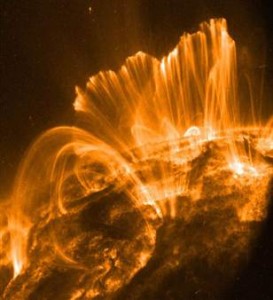Solar flare running toward Earth
U.S. politics had its “Super Tuesday” yesterday, and so did the sun – says Joseph Kunches from NOAA’s Space Weather Prediction Center in Boulder, Colorado.
That’s because the sun had two solar flares associated with two coronal mass ejections. Coronal mass ejections involve massive amounts of energy and charged particles shooting out of the sun, and can cause problems if directed at Earth, as was the case over the last couple of days.
This event may stir up a geomagnetic storm, and lead to disruptions to high-frequency radio communications, global positioning systems and power grids, NASA’s Goddard Space Flight Center said Wednesday. The peak of the storm is expected to hit Thursday morning; it may gradually diminish by Friday morning.
One of these coronal mass ejections is the strongest since December 2006 – NOAA said. The equivalent of 10 billion tons of highly charged particles are hurtling at a rate of 3 million to 4 million miles an hour toward Earth. NASA says the leading edge of this coronal mass ejection will hit Earth at 1:25 a.m. E.T. (give or take seven hours).
The sun is currently in a cycle of increased sun spots. This is part of an 11-year cycle that is expected to peak over the next year. The magnetic field in a sunspot stores energy that is released in solar flares. These flares are intense bursts of radiation that get ejected into space.
NOAA measures various aspects of the ejections that occur. Four main components define solar activity – solar flares, coronal mass ejections, high-speed solar wind and solar energetic particles.
As an event occurs, some of the particles reach Earth almost immediately. These highly charged particles are more of a threat to spacecraft and astronauts than to us on the planet’s surface. The bulk plasma from the coronal mass ejection can take between 30 and 72 hours to reach the earth. This can cause interruptions to power grids, GPS systems, and some flights that are near the poles.
Earth’s magnetic field is about to be shaken like a snow globe by the largest solar storm in five years.
After hurtling through space for a day and a half, a massive cloud of charged particles is due to arrive early Thursday and could disrupt utility grids, airline flights, satellite networks and GPS services, especially in northern areas. But the same blast also could paint colorful auroras farther from the poles than normal.
Scientists say the storm, which started with a massive solar flare early in the week, is growing as it races outward from the sun, expanding like a giant soap bubble. When it strikes early Thursday, the particles will be moving at 4 million mph (6.4 million kph).
“It’s hitting us right in the nose” – said Joe Kunches, a scientist for the National Oceanic and Atmospheric Administration in Boulder, Colorado.
Astronomers say the sun has been relatively quiet for some time. And this storm, while strong, may seem fiercer because Earth has been lulled by several years of weak solar activity.
The storm is part of the sun’s normal 11-year cycle, which is supposed to reach peak storminess next year. Solar storms do not harm people, but they do disrupt technology. And during the last peak around 2002, experts learned that GPS was vulnerable to solar outbursts.
Because new technology has flourished since then, scientists could discover that some new systems also are at risk – said Jeffrey Hughes, director of the Center for Integrated Space Weather Modeling at Boston University.
A decade ago, this type of solar storm happened a couple of times a year – Hughes said.
“This is a good-size event, but not the extreme type” – said Bill Murtagh, program coordinator for the federal government’s Space Weather Prediction Center.
With a little luck, Western Washingtonians could get a good view of the aurora borealis tonight and Thursday night.
A big solar flare and possibly clear skies over Western Washington could give residents an eyeful of northern lights after midnight tonight and again Thursday evening. The eruption on the sun is the largest since December 2006 – said Joe Kunches, a spokesman and space scientist at NOAA’s Space Weather Predication Center.
A similar eruption in late January also gave Washingtonians a shot at seeing the aurora, which is normally only visible closer to the Earth’s poles. During that solar eruption, however, cloudy weather blocked our view. Scandinavia got a great show, though.
The uptick in big eruptions is thanks to a new solar activity cycle with more frequent eruptions. Prior to about a year ago, the sun was in a pretty dull cycle. Now, the surface is lighting up.
“The sun’s done its part” – Kunches said. “It had a big eruption. The local weather conditions are gonna be the issue: You live in Seattle.”
Fortunately, Dennis D’Amico, a meteorologist for Seattle’s National Weather Service, said Western Washingtonians have a decent chance of getting clear skies both nights. There may be some clouds late tonight and into early Thursday morning, but early Thursday evening could be clear in the region.
Tonight, people south of Seattle have a greater chance of getting a clear look, D’Amico said. However, the moon may limit the show.
Kunches said weather-worn Washingtonians might get rewarded for braving the spring evening.
“You’ve got a tough breed up there” – he said. “Standing out there in the cold in the dark for a while, you might get lucky.”
